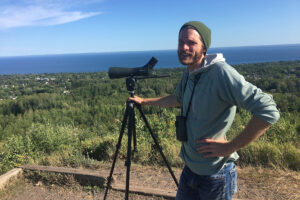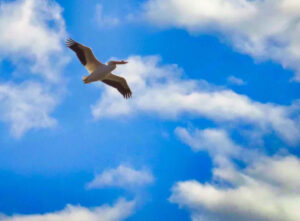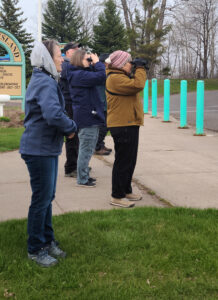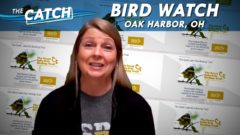Where to find birds in the St. Louis River Estuary

Steve Kolbe on Hawk Ridge in Duluth, Minnesota. Image Credit: Natural Resources Research Institute
The final talk of the 2022-23 River Talk season took place in early May. Steve Kolbe, an avian ecologist with the University of Minnesota Duluth’s Natural Resources Research Institute, gave a presentation about where to find birds in the St. Louis River Estuary and led attendees on a short bird walk on Barker’s Island in Superior near the Lake Superior Estuarium.
“The reason I live in this area is because of birds, specifically because of bird migration,” Kolbe said. “This is an amazing part of the world, both in the fall and in the spring. Birding isn’t just a hobby for me. It’s not just a job. It’s sort of like an obsession.”
Spring
Kolbe began his talk with the snowy owl. They’re often seen in winter on Barker’s Island and the Superior Airport and surrounding area. Their preferred habitat is the Arctic tundra, so they like the open spaces that the airport provides.

An American white pelican files over the St. Louis River at Chambers Grove. Image credit: Marie Zhuikov
Trumpeter swans are some of the first birds to migrate through in the spring after ice-out. Kolbe often finds them in Rask Bay on the St. Louis River.
American white pelicans stage in groups in the spring in Chambers Grove along the river. “For whatever reason, they like the little island in the middle of the river. They hang out there for almost a month before heading farther north,” Kolbe said.
Bonaparte’s gulls can be found in Lake Superior off Lafayette Square on Park Point en masse. “This is one of my all-time favorite birds and an area specialty. The first week in May, these beautiful, vocal and awesome-looking small gulls with a black head and a silver back with red legs stage on Lake Superior. They hang out for a day or two and then leave in a huge flock,” he said.
Summer
American bitterns breed in Mud Lake and Allouez Bay in wetlands.
Common terns breed on Interstate Island – the sandy island that can be seen off the Blatnik Bridge. Kolbe said they winter in Peru, so they “put on a lot of miles.” The island is protected, so people can’t visit it without a permit. The best place to see them from the mainland is at Rice’s Point boat launch in Duluth with binoculars or a spotting scope.
Fall
For work, Kolbe studies rusty blackbirds. He said this wetland species likes to spend time in North Bay on the river and on many of the islands below the Fond du Lac Dam. Unlike most fall migrants, these blackbirds stay in the area for an extend time – two or three weeks. He suspects they may be using that time to molt their feathers. “Whatever they’re doing, it’s obviously a really important spot,” Kolbe said.

River Talk participants view birds on Barker’s Island. Image credit: Marie Zhuikov, Wisconsin Sea Grant
Parasitic jaegers migrate along Wisconsin Point in September. These birds are known for their feeding style, which involves stealing food from gulls. “They look like a gull mixed with a peregrine falcon,” Kolbe said. “It’s certainly not a bird that you see many places. They nest in the high Arctic and winter at sea. So, it’s cool to be able to see them in Duluth and Superior.”
Flocks of sanderlings and a few piping plovers can be found on area beaches in fall and spring.
Kolbe studied the common nighthawk for his master’s degree. They are another species that migrates en masse along the shore of Lake Superior during fall. “In the second half of August, if you get a really warm day with light winds, go outside in the evening and look up. If you’re lucky, you’ll see something on the order of 15,000 of these birds,” Kolbe said. He’s been counting the birds during their migration for the past 15 years. He uses the information to develop population trend information for the species. “They seem to be doing OK,” he said.
Hawk Ridge in Duluth is a great place to see hawks and other birds in the spring and fall. Bald eagles are a common species of interest who are here year-round. “It’s really a success story that we’re able to enjoy them so readily and easily around here,” said Kolbe.
During a walk around Barker’s Island, the group saw a mix of birds: buffleheads, a horned grebe, red-winged blackbirds, mallards, a rock pigeon, a common merganser, a song sparrow, ruddy ducks and herring gulls.
River Talks will begin again for its 11th season next fall. In the meantime, there’s a new spinoff series that the Lake Superior National Estuarine Research Reserve has begun for summer, called River Walks. Find more info about it here.
The post Where to find birds in the St. Louis River Estuary first appeared on Wisconsin Sea Grant.
Blog | Wisconsin Sea Grant
https://www.seagrant.wisc.edu/blog/where-to-find-birds-in-the-st-louis-river-estuary/?utm_source=rss&utm_medium=rss&utm_campaign=where-to-find-birds-in-the-st-louis-river-estuary

